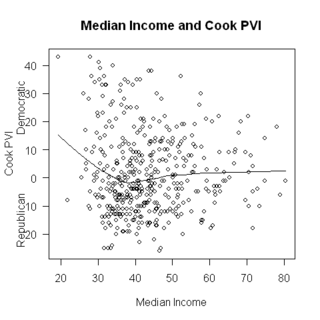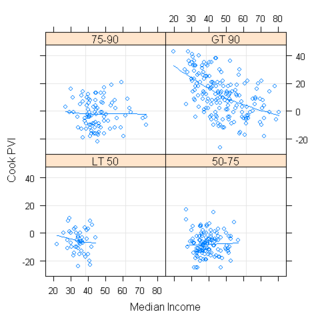(Fascinating stuff; be sure to check below the fold for the full analysis. What’s your take? – promoted by James L.)
Based on recent generic ballot polls and the current distribution of Republican incumbent and open seats, Democrats would pick up about 25 more House seats in the 2008 election if it were held today. Republicans might pick up a couple to offset that.
And that’s before we account for future Republican retirements and the massive fundraising advantage Dems have this year.
Of course, the generic ballot numbers will probably change over the next year, one way or the other. Here’s how the number of House seats Democrats would win varies as the Democrats’ generic ballot advantage changes so you can keep track at home (based on retirements known as of November).

Click to enlarge.
The colored bands show the maximum and minimum calculations, but the actual numbers are most likely to be close to the solid lines. Currently the average Democratic generic ballot advantage is about 12; the max I’ve seen this year is 18, the min is 7.
Below, the explanation and the fine print.
Cross posted at DailyKos and Open Left.
Bonus Fun Calculation
If Democrats in 2006 had had the same wealth of seats available to them to contest as Republicans did in 1994, they would have picked up an estimated 59 seats! This means the election of 2006 was just as big a win for Democrats in terms of performance as the election of 1994 was for Republicans.
The Fine Print
1. These calculations are based on the average generic ballot advantage in the final week of the campaign, which we don’t know yet. All we know are what the current polls say. So if Democrats maintain their current generic ballot advantage through the end of the campaign season, then we would expect 25 more Democratic seats.
2. The calculations are based on the current known Republican retirements in the House. The more Republican retirements, the better for Democrats. I will post an update later in 2008 once retirements have settled out.
3. I assume that the campaigns and party strategies in 2008 will be similar enough to those in 1994-2006. This assumption could be wrong, if, for example, Democrats work just as hard at challenging incumbents as they do at going for open seats. In that case, the current estimates would be a few seats too optimistic (but the generic ballot advantage would likely increase by a large amount and more than offset that).
4. Strictly speaking, we wouldn’t want to make any predictions for a generic ballot advantage greater than what we saw in 2006, because it is beyond the range of previous experience. I wouldn’t worry too much about going a little beyond the generic ballot advantage of 2006, but once we get up into the 18 point generic ballot advantage range, things get uncertain. And at that point, who cares about predictions? It would be celebration time….
Predicting the House
The relationship between generic ballot numbers and the numbers of seats won by Democrats is not that great.
Why not? After all, the generic ballot number takes into account every major and minor factor in individual races, including the national mood.
The problem is that the number and distribution of seats held by each party varies over time. For example, in 1994, Republicans had a rich field of conservative and moderate districts held by Democrats to try to take. Today, there are far fewer. (Another problem may be changing political habits over long periods of time.) Previous calculations that took the distribution of seats into account for the 2006 election were almost exactly right.
In this diary, I use the eight most recent elections to create a way to calculate the number of incumbent or open seats won by either party. The only numbers needed for this calculation are the Democrats’ generic ballot advantage (from polls), the percent support for Bush in 2000 in each district, and the status of each race (incumbent Democrat, open seat held by Democrat, incumbent Republican, or open seat held by Republican). Note that the best way make these calculations is to run thousands of simulations and count up the outcomes, something I did not do.
The Details
So, how does partisan makeup of a district relate to the chance of a seat switching parties, on average? In 2006 we had a lot of seats switch from Republican to Democrat – so we can try to answer this question for the R to D switch at least.
Here’s a graph showing the percent chance that a seat switched when the incumbent was a Republican. The data are divided into categories with a range of 3 points in Bush’s 2000 vote. Please note: this graph, or any of the following, is not useful for predicting the chance of a specific seat changing parties in the 2008 elections.

Click to enlarge.
There’s a regular and not unsurprising pattern here. Democrats were more likely to win in the more moderate districts. Looking at the data another way (not shown) leads me to believe this is pretty close to the shape of a common type of curve, so we can model it:

Click to enlarge.
The ‘center’ of the curve shows us where Democrats were able to win 50% of the Republican seats: in districts where Bush received 44% of the vote. Now let’s add in open seats held by Republicans:

Click to enlarge.
With far fewer open seats, the data points look far less organized. Note that the curve for open seats shifts 8 points to the right. This shows us the total advantage of being a Republican incumbent. Of this advantage, 2 points can be accounted for by the inherent incumbency advantage identified after taking fundraising into account (name recognition and so forth); the rest is probably attributable to stronger opponents with more money running for open seats.
These curves have two numbers that are used to describe them: one tells us where the center is – what the level of Bush support was in 2000 in districts where Democrats won 50% of the time – and the other tells us how steep the curve is. The steepness is about the same for incumbents and open seats.
At this point we could quit and go home and use these curves alone, because as it turns out, the generic ballot for 2008 is sitting right about where the generic ballot for 2006 was. But we’d like to get some idea of the possible range we might see for a given generic ballot number, and what happens if the generic ballot numbers change.
The only other recent year with a fair number of Democrats winning Republican seats is 1996, but it’s still not enough to get a very accurate curve. Even so, when you look at the numbers, the steepness is not significantly different from the 2006 curves. The center is shifted 7 points to the left.
But what about the other years? It turns out we have another way to estimate the center. We can plot the percent that voted for the Republican in each district versus the percent Bush had in 2000, and with a regression curve, estimate where half the Republicans lose (fall below 50%), which is our number for the center of the curve. Several different types of regressions lead to similar numbers.
If we assume the curves all had the same steepness in every year, we can check our estimates by seeing if we can predict how many Republican seats Democrats won in each year by multiplying the number of districts with a given support of Bush in 2000 by the chance that districts with that level of support were won by Democrats. This is repeated for incumbent seats and open seats. The center is shifted 8 points to the right for open seats. As it turns out, these estimates work great.
Repeating the process for Democratic-held seats, using the 1994 election as a basis, is a little trickier because Democrats seem to be a lot better at holding on to seats in conservative districts. The upshot is the estimates of Republican wins of Democratic seats have a lot more error associated with them. Fortunately, right now the generic ballot is in the range where even a large relative error in the number of seats picked up by Republicans doesn’t make much difference – 1 plus or minus 300% is still only a few seats. But, what we can do now is generate some rough curves for Democratic seats in 2006, even though no Democrats lost their seats. And for fun, let’s look at 1994 too.

Click to enlarge.
One thing that jumps out is that Democrats seem to have a much bigger total incumbency advantage than Republicans. This, again, may be related to the tendency of Democrats who represent conservative districts to retain their seats. Or, the Republicans maybe have a bigger actual total incumbency advantage than the 8 points found above.
Now, the key question: can we predict where the center of these curves will be from polling data? Here’s a graph of the estimated or modeled center versus the final week’s generic ballot advantage for Democrats running against Republican incumbents:

Click to enlarge.
Looks good. Two points are hollow – 1994 and 1996 – because I am not sure I have all the polling in the average (the other years came from pollingreport.com). The line is about the same with or without those two points though. The dashed lines show the range we expect the center to be in 95% of the time, given a known generic ballot advantage. So now we have a way to relate the generic ballot to the center of our curves up above, and we can use the curves to estimate the number of Republican seats won by Democrats:

Click to enlarge.
Not too shabby. If you split it up between open and incumbent seats, the calculations for incumbents are usually a little too optimistic, and the calculations for open seats are a little too pessimistic. This might mean the actual total incumbency advantage for Republicans is more like 10-12 points than the 8 points calculated above for 2006.
Repeating the exercise with Democratic-held seats results in a much greater error, as there was more error in generating the curves for each year, but again, this doesn’t matter much at the current generic ballot range.
Thus Ends the Adventure
This is the last in a short series related to House elections. Other diaries discuss the current political climate nationally and factors such as retirements, recruitment, and fundraising in the House races; the the changing landscape in the House since 1994 as far as the seats controlled by each party; the change in voting behavior at the presidential level from 1988 to 2004 (with an eye towards the next redistricting session); and finally, two more diaries showing how much various factors (money, incumbency, party, scandal) hurt or help candidates for the House on average.









